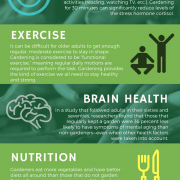Your health today could be helped by looking back thousands of years. Reach into history and you’ll find an ancient wisdom and practice that you may have heard of, but might not truly understand—Traditional Chinese Medicine (TCM).
TCM is one of the world’s oldest forms of medicine. But in a world predominantly using Western medical science, the popularity of Traditional Chinese Medicine is regaining popularity. Many of the principles and ancient wisdom of TCM are being integrated into holistic strategies for health today.
Traditional Chinese Medicine is Thousands of Years Old
TCM—also often referred to as “Eastern Medicine”—originated in ancient mainland China. It dates back more than 2,500 years and has evolved and been perfected ever since. Even for those relying on modern “Western Medicine” which, is only a couple of hundred years old. However, there is likely a lot that can be learned from TCM practices.
But what exactly is Traditional Chinese Medicine? An understanding of the premises of TCM starts with the underlying philosophies.
Yin and Yang is the Basis of Traditional Chinese Medicine
Nature is the primary hallmark of TCM. The basic premise of TCM is that our bodies are a microcosm of our surrounding world and universe. You have probably heard of “yin” and “yang” (or at least seen the symbol).
Yin and yang is the basis of Eastern science and TCM. It is the concept that opposing forces are actually complimentary, essential, and need to exist in balance and harmony for optimal health. Some examples are:
- light and dark
- positive and negative
- fire and water
- good and evil
- male and female
- expanding and contracting
Think about it this way. Shadows cannot exist without light. And the premise of many modern superhero movies—good cannot exist without evil.
The basic underlying premise of yin and yang in TCM is these seemingly opposite forces need to exist in balance and harmony. Harmony between yin and yang is thought to promote health. But imbalance is thought to result in disease.
Qi—or Life Force—is an Important Concept in Traditional Chinese Medicine
Qi (pronounced “Chee”), is generally defined as the vital energy that flows through the bodies of every living thing. The literal translation from the Chinese characters means “molded by the energy of the nature”. The Chinese believed that Qi permeated everything and linked their bodies’ to the surrounding environment.
The concept of Qi is deeply rooted in Traditional Chinese Medicine. The concept was first noted in the oldest TCM scriptures, aptly named the ‘Internal Scripture.’ The concept is that vital energy circulates through our bodies in pathways referred to as meridians. Symptoms or overt illnesses are believed to be the result of blocked, disrupted, or unbalanced Qi moving through our meridians.
A properly flowing Qi is believed to be responsible for many aspects of health. Thus, a major focus of TCM practices is often targeted at unblocking and allowing our Qi to properly circulate throughout our bodies.
There are Four Types of Qi
As mentioned above Qi is the energy that is moving throughout our bodies and the world around us. But there can be other energies that can affect our circulating life force. Early Chinese philosophers and other Eastern practitioners built on this notion of Qi. They further postulated there were sub-fractions of Qi.
Generally speaking, the major subcategories of Qi became:
- Inborn Qi—related to genetics and cellular makeup
- Pectoral Qi—related to metabolism and consists external factors like air and food
- Nutritive Qi—related to diet and other nutritive factors
- Protective Qi—related to protection from the outside world or immune health
Together these various Qi are said to form interdependent networks in the body and affect:
- Mental health
- Emotions
- Internal organ function
- Sensory organ function
- Heart health
- Skeletal and connective tissue
- Body fluids
- Aging
Thus, a basic premise of TCM is that a properly flowing and well interconnected Qi is essential for optimal health. This concept has been recently embraced by Western medical science. Systems biology is the study of complex biological systems and the networks that connect them.
These connections can be through nerve conduction, hormones, signaling molecules, electrical impulses, or even external cues like day and night. It is also the appreciation that a single input (diet, exercise, medicines, stress etc.) does not just affect one cell, or one organ, or even one biological system. Rather, an input can have very wide-reaching effects on our physiology—a concept that has been appreciated by TCM for 1000s of years.
Healthy Qi is Incorporated into Many Aspects of Eastern Philosophies
The concept of energy moving around and through every aspect of ourselves and life around us has permeated into many aspects of early Eastern cultures; many of which, have become relatively mainstream—or at least heard about—in more modern Western civilizations. These major aspects include:
- Feng Shui—the concept of harmonizing energy in the placement and arrangement of physical objects in a space. This careful balancing of Qi through a space can affect health, wealth, and vigor of the occupants.
- Qigong—the concept of balancing Qi through coordinated movement, awareness, rhythmic breathing, and meditative states. It is utilized during exercise, healing, and training for martial arts.
- Martial arts—related to Qigong, this concept is known as Neijing. It often involves slow, choreographed movements, and visualization to both learn a martial art and to focus internal Qi force to achieve great feats of strength.
- Medicine—a number of medical practices can be used to help realign Qi. These can include herbology, acupuncture, moxibustion, and reflexology.
- Parenthood—for many centuries birth has been thought to be the result of the coming together and intertwining of the Qi from a male and female. In TCM, this is referred to as joining energy or the joining of essences.
There are Five Elements Represented in Traditional Chinese Medicine
Another important philosophy in Eastern Medicine are what is known as the “Five Phases” or “Five Elements”. Symbolically these five elements represent all phenomena, including the stages of human life, and explain the functioning of the body and how it changes during health or disease.
The five elements—or phases—of TCM include and philosophically represent:
- Fire—a time brimming with flowering and brimming with energy.
- Earth—a time of transition as in the changing of seasons.
- Wood—a time of growth (think about trees sprouting in the spring).
- Metal—a time of harvesting and collecting.
- Water—a time of stillness and retreat.
Benefits of Traditional Chinese Medicine
Ancient TCM concepts emphasize a natural, preventive approach. At the core of the Traditional Chinese Medicine philosophy is that corrective, preventative action can help if the right steps are taken. This starts with detailed observation by a well-trained practitioner. They look for disruptions in one of the principals of TCM, and provide actions to take. These practitioners claim to catch problems before traditional Western medicine would.
However, if these early observations are not acted upon, disruptions in one aspect of TCM will lead to disruptions in other aspects of TCM principals and overt disease can manifest. This comes from the ideas of connection you read about above.
Traditional Chinese Medicine’s preventative focus makes it a good pair with Western medical science. This mixing of philosophies can create synergistic results for your health.
And the crossover between Western medicine and the teaching of TCM goes even deeper. Just look at the use of reishi mushrooms to support protective Qi. Western scientific research has found that the beta-glucans—a complex carbohydrate often found in certain plants, fungi, and bacteria—in these mushrooms play a role in immune health through cell signaling.
TCM had the knowledge, remedies, and history of success, and Western medicine found the biological underpinnings. Together this gives us a complete picture of the benefits and an understanding of why something works.
Traditional Chinese Medicine Treatments
TCM has crept into literally every society around the world. But it can go by a number of different names. Some of the most popular names are: complementary and alternative (CAM) medicine, integrative medicine, Eastern Medicine, functional medicine, holistic medicine, and alternative medicine.
But whatever you call it, practitioners use a variety of protocols to treat what is believe to be at the root of an underlying health condition. These can include interventions around nutrition, diet, herbal remedies, and various mind/body practices. These treatments can include acupuncture, cupping, therapeutic massage, scrapping, reflexology, bone setting, chiropractic techniques, breathing, exercise, and self-defense trainings.
More recently, incorporation of modern and conventional techniques, such as pharmaceuticals and surgery, can also be incorporated into Traditional Chinese Medicine approaches or vice versa. Think about how breathing techniques, massage, or acupuncture can supplement and enhance a modern, Western medical approach.
Bridging the Gap Between TCM and Your Modern Life
Today you have television, mobile phones, cars, and all the trappings of modernity. So how can an understanding of medicine from thousands of years before the Internet—or even the microscope—help you today?
It’s all about connection.
TCM is based on your connection to the world around you. And the principles of Qi—the flowing of energy through you—is based on the connectedness of your whole body.
You don’t have to memorize the terms or lists of remedies to connect your modern life to traditions that have stood the test of time. The observations and treatments might be something for you to explore. And things like therapeutic massages and martial arts exercise are fairly common today.
But you don’t even have to go that far. Understanding TCM and incorporating the principles into your life can be simple.
Start by taking a holistic approach. Strengthen your connections to the outside world (with things like gardening or forest bathing) and those connections that exist inside you. Think about how your intellect, emotions, and physical being are tied together, for instance. That’s a simple way that Traditional Chinese Medicine principles can help you strengthen your holistic health and wellness. It can guide you as you develop a healthier lifestyle that connects the pillars of physical, emotional, environmental, nutritional, and spiritual health.























